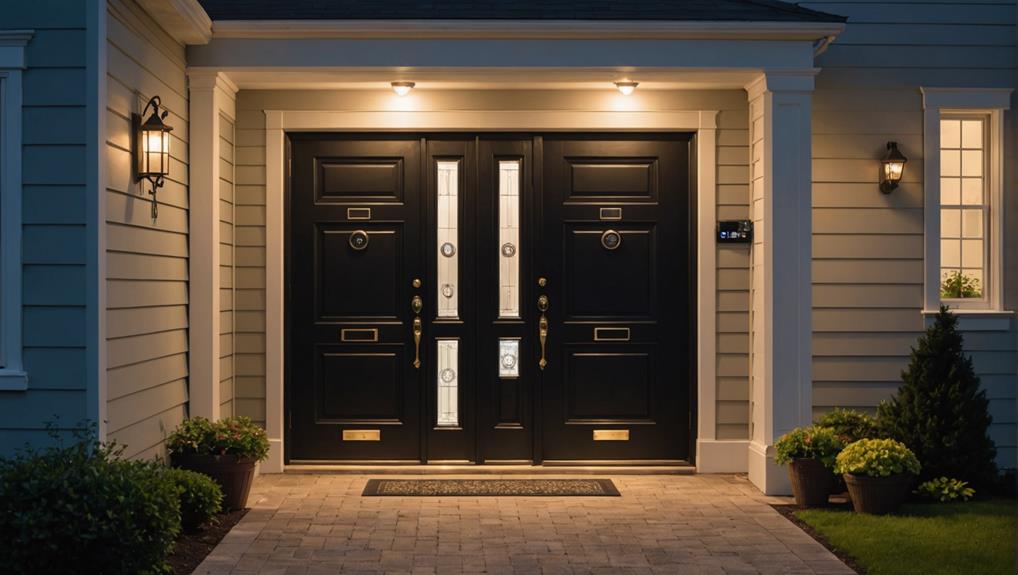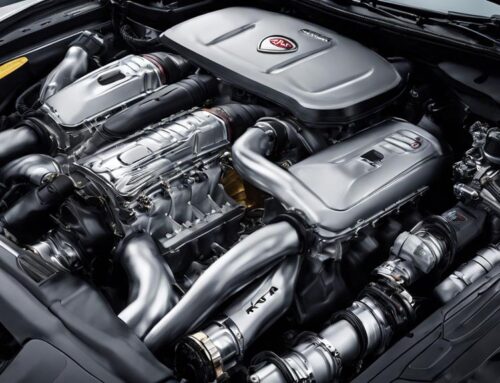To grasp the fundamentals of residential security systems, start by acknowledging their purpose in shielding your home and family from potential dangers. These systems encompass components like cameras for real-time monitoring, sensors for detecting movements, and environmental detectors for hazardous conditions like smoke or carbon monoxide. By comprehending the basics, you empower yourself to make informed decisions that enhance your safety and security.
Key Takeaways
- Components include cameras, sensors, and environmental detectors for comprehensive protection.
- DIY and professional systems offer wired or wireless options for varied preferences.
- Real-time monitoring provides instant alerts via mobile notifications for quick responses.
- Security cameras with HD footage, night vision, and cloud storage enhance surveillance capabilities.
- Visible security features like alarms and cameras deter about 60% of burglars from targeting protected homes.
Definition and Functionality

Residential security systems are fundamental for safeguarding your home and loved ones. A home security system, as outlined in this home security guide, encompasses a range of components designed to protect your property and occupants.
These components, which include home alarm systems, consist of cameras, sensors, and environmental detectors that work together to detect unauthorized entry and potential threats like burglary and fire.
The primary functionality of these systems involves real-time monitoring, alerting you via mobile notifications, and triggering alarms when unauthorized access is detected.
Security cameras provide live footage with features like night vision and cloud storage for easy event review. Some advanced systems even integrate with smart home devices for seamless control and automation.
Entry sensors and motion detectors play significant roles in identifying breaches, while environmental sensors guarantee safety by monitoring for hazards like smoke and carbon monoxide.
Understanding the definition and functionality of these components is essential in creating a robust security system for your home.
Types and Components

When it comes to residential security systems, it's essential to understand the different types available and the components that make them effective.
From DIY setups that you can assemble yourself to professional systems installed by security companies, each type has its unique features. For instance, DIY setups offer more flexibility and often lower costs, whereas professional systems provide a higher level of reliability and support.
Components like entryway sensors, motion sensors, and security cameras play important roles in safeguarding your home and loved ones.
System Types Overview
When selecting a residential security system, it's essential to evaluate the types and components that align with your home security needs.
Here is an overview of the system types to help you make an informed decision:
- DIY Systems: User-assembled and monitored via mobile apps.
- Professional Systems: Installed and monitored by security companies like ADT or Vivint.
- Wired Systems: Hardwired into a home's electrical system for reliability.
- Wireless Systems: Utilize battery-operated sensors that connect via Wi-Fi or cellular networks for easier installation.
- Smart Systems: Enhance home security through internet connectivity, offering features like remote monitoring, live video streaming, and integration with other smart home devices.
Understanding the different types of residential security systems can aid in selecting the one that best suits your needs.
Whether you opt for a DIY system for more control or a professional system for added convenience, ensuring the integration of key components like entryway sensors and security cameras can enhance the overall effectiveness of your home security setup.
Component Functions Defined
After understanding the diverse types of residential security systems available to safeguard your home, it's now crucial to explore the specific functions of key components that form these systems.
The basics of home security systems include entry sensors that detect unauthorized access through doors and windows, while motion sensors monitor movement in designated areas, alerting you to any unusual activity.
Security cameras are essential for visual surveillance, equipped with features like night vision and live streaming for remote monitoring.
In case of emergencies, panic buttons provide quick alerts to monitoring centers for immediate assistance during crises such as home invasions.
Glass-break sensors add another layer of security by detecting the sound of breaking glass, triggering alarms to deter intruders.
Additionally, environmental sensors like smoke and carbon monoxide detectors continuously monitor for dangerous conditions, ensuring home safety even when the security system is disarmed.
Understanding these component functions is fundamental for a thorough home security setup.
Key Features Highlighted
Highlighting the key features of residential security systems involves understanding the types and components that play an important role in safeguarding your home.
Here are some key components to examine:
- Security Cameras: Provide HD video footage, two-way audio, and night vision capabilities for enhanced monitoring.
- Entry Sensors: Use magnetic fields to alert you when doors or windows are opened, significant for perimeter security.
- Motion Detectors: Differentiate between pets and humans to reduce false alarms, monitoring unusual activity within designated areas.
- Environmental Sensors: Monitor changes like temperature and humidity, alerting you to potential threats such as fires or leaks.
- Glass-Break Sensors: Detect the sound of breaking glass, adding an essential safeguard against break-ins through windows.
Understanding these features can help you choose the right residential security system to protect your home effectively.
Professional Monitoring

Professional monitoring is a critical component of residential security systems, offering round-the-clock surveillance by trained professionals who promptly respond to alerts and emergencies.
These services guarantee that potential threats are addressed swiftly, providing a sense of security and peace of mind for homeowners. The monthly fees for professional monitoring can vary based on the level of service and features included, such as police dispatch or fire department notifications.
The initial setup and equipment costs can also impact overall expenses. Alerts are usually directed to law enforcement unless there's video verification to confirm the situation.
Integrating professional monitoring with local authorities can improve emergency response effectiveness, potentially reducing the impact of incidents. Additionally, homes with professionally monitored security systems may qualify for discounts on homeowners insurance premiums, as they're statistically less likely to experience burglary.
Investing in professional monitoring not only enhances the safety of your household but also offers financial benefits and added protection against security threats.
Pros and Cons

Integrating professional monitoring with local authorities can enhance the effectiveness of emergency responses, potentially reducing the impact of incidents.
When considering residential security systems, it's important to weigh the pros and cons:
- Enhanced Protection: Security systems deter intruders, making homes with alarms 300% less likely to be burglarized.
- Cost Considerations: Initial setup costs around $400, with varying monitoring fees impacting long-term affordability. Additionally, ongoing costs for maintenance, equipment updates, and repairs can add up over time.
- False Alarms: Improper usage can waste emergency resources and lead to fines, emphasizing the need for proper maintenance.
- Insurance Benefits: Systems with emergency response features might lead to insurance discounts, offsetting monitoring costs.
- Privacy Concerns: Surveillance features can raise privacy worries due to constant monitoring, potentially causing discomfort about personal activities being recorded.
Understanding these factors can help you make an informed decision when it comes to securing your home effectively.
Importance of Home Security

Securing your home with a reliable home security system is an essential step in safeguarding your property and loved ones. Home security systems play an important role in deterring crime, with research showing that homes with alarms are 300% less likely to be burglarized compared to those without.
In the U.S. alone, around 2.5 million burglaries occur annually, underscoring the pressing need for effective security measures. Investing in a security system not only reduces the likelihood of a break-in but also provides peace of mind to homeowners.
Visible security features like alarms and cameras act as strong deterrents, dissuading about 60% of burglars from targeting protected homes. Professional monitoring services offer 24/7 surveillance, ensuring swift responses during emergencies like break-ins or fires to minimize potential damage.
Additionally, installing security systems can provide homeowners with peace of mind and even lead to insurance discounts, as some insurers offer reduced premiums for homes with active security measures.
Prioritizing home security is a proactive measure that greatly enhances the safety and protection of your household.
Overview and Importance

An essential aspect of ensuring the safety and protection of your home and loved ones is the installation of a reliable residential security system. These systems are designed to detect unauthorized entry and emergencies, safeguarding your property and occupants from threats like burglary, fire, and flood.
With approximately 2.5 million burglaries occurring annually in the U.S., having an effective security system is vital to deter such incidents. Studies show that homes with security alarms are 300% less likely to be burglarized compared to those without any security measures.
Visible security measures, such as alarms and cameras, play a significant role in deterring potential burglars, as 60% admit they'd avoid a home with a security system. Additionally, investing in a home security system can lead to potential savings on homeowners insurance, as many providers offer discounts for homes with monitored security systems.
However, understanding the costs involved, including initial setup and long-term expenses, is essential for making an informed decision.
- Protection from unauthorized entry and emergencies
- Deterrence of burglaries, fires, and floods
- Decreased likelihood of being burglarized
- Visible security measures deter potential intruders
- Potential savings on homeowners insurance
Core Components

When setting up a residential security system, understanding the core components is vital. The control panel serves as the central hub for system communication and user interaction.
Security sensors and cameras play key roles in detecting and monitoring potential security threats.
It's important to evaluate your home's specific security requirements to select the most appropriate system. Different homes may require unique configurations of these components to guarantee thorough protection.
Essential Components Overview
To grasp the backbone of residential security systems, one must understand the core components that form the foundation of home protection. Here is an overview of the essential components:
- Master Control Panel: Acts as the central hub for system controls and communications.
- Entryway Sensors: Detect unauthorized access through doors and windows.
- Motion Sensors: Identify unusual activity within designated areas of the home.
- Security Cameras: Provide visual monitoring and real-time recording capabilities.
- Environmental Sensors: Protect against hazardous conditions like smoke and carbon monoxide.
These components work together seamlessly to guarantee your home remains secure and protected.
The master control panel allows you to monitor and manage your security settings, while sensors and cameras keep a watchful eye on your property.
Environmental sensors provide added safety by detecting dangerous conditions, and high-decibel sirens serve as a deterrent by alerting you and your neighbors to potential threats.
With these core components in place, you can have peace of mind knowing your home is well-equipped to handle any security concerns.
Sensor Functionality Explained
Understanding how sensors function within residential security systems is key to grasping their significance in safeguarding your home.
Entryway sensors work by using a magnet and sensor duo to detect when doors or windows are opened, instantly alerting homeowners through mobile apps if a breach is detected.
Motion sensors rely on passive infrared technology to sense movement in specific areas, with advanced models able to differentiate between pets and humans to minimize false alarms.
Glass-break sensors are designed to listen for the distinct sounds or vibrations produced by breaking glass, setting off alarms and notifications upon detection.
Environmental sensors are essential in monitoring for smoke, carbon monoxide, and water leaks, issuing critical alerts to prevent potential hazards regardless of the security system's status.
In addition, most modern security systems allow seamless integration of sensors with other devices, offering thorough monitoring and automated responses to any detected events.
Camera Features Analysis
Incorporating essential components for effective home security, analyzing camera features is crucial for maximizing monitoring capabilities.
When evaluating security cameras for your residential needs, consider the following features:
- High-Definition (HD) Quality and Night Vision: Capture clear footage, day or night, ensuring ideal visibility at all times.
- Two-Way Audio: Communicate with visitors or deter intruders through integrated speaker and microphone functionalities.
- Cloud Storage Options: Securely store recorded footage in the cloud for remote access and incident review via mobile apps.
- Motion-Activated Recording: Save storage space by capturing footage only when motion is detected, enhancing efficiency.
- Smart Technology Integration: Connect cameras to home automation systems for seamless control and alerts through smartphones or voice assistants.
Entryway and Motion Sensors

Enhance the security of your home with the strategic placement of entryway and motion sensors.
Entryway sensors, utilizing magnetic fields, detect unauthorized access through doors and windows, triggering alerts for enhanced protection. It's recommended to install them on all ground floor entries and accessible second-floor windows.
Motion sensors, on the other hand, monitor specific areas for unusual activity by identifying movement using technologies like passive infrared or laser detection. These sensors can distinguish between people, pets, and objects, reducing false alarms.
Motion sensors are particularly effective when integrated with other security measures like alarms and cameras. For added security, advanced motion sensors can be integrated with floodlights, activating lights and alerts upon detecting movement.
Entryway sensors offer DIY convenience with adhesive installation and mobile alerts, while motion sensors can be strategically placed in high-traffic zones for ideal coverage.
Both these sensors are essential components of a thorough home security system, providing real-time notifications and deterring potential intruders, ensuring your peace of mind.
Frequently Asked Questions
What Are the Basics of Security Alarm System?
To set up a security alarm system, you need a control panel, entry sensors, motion sensors, and sirens.
Entry sensors use magnets to trigger alarms when doors or windows are opened, while motion sensors detect movement with infrared or laser technology.
The system's siren emits loud alarms to notify you of potential intrusions.
Monitoring services offer 24/7 surveillance and quick emergency responses, while self-monitored systems send alerts directly to your phone.
What Are the Principles of Home Security System?
To protect your home, remember these principles of a security system: deterrence through visible measures like cameras and alarms, detection using sensors for entry or motion, and rapid response by professionals monitoring your property 24/7.
With wireless tech integration, you can easily control and monitor your system. Burglars avoid homes with security systems, making your property less appealing to potential threats.
What Are the 4 Types of Alarm Systems?
The four types of alarm systems are DIY, professional, wired, and wireless.
DIY systems let you set up and monitor your security easily, usually at a lower cost.
Professional systems are installed and monitored by security companies for a more complete solution.
Wired systems are hardwired into your home, providing reliable connectivity.
Wireless systems offer simple installation and flexibility.
Each type can be customized based on your needs and preferences.
How Do Home Security Systems Work?
Home security systems work by using sensors, cameras, and alarms to detect intruders or emergencies.
Entry sensors monitor doors/windows, while motion sensors detect movement, triggering alarms. Cameras provide live footage and recordings for remote monitoring.
Some systems connect to monitoring services for 24/7 surveillance. Wireless systems use Wi-Fi or cellular networks for reliability. They can be easily expanded with more devices.
Conclusion
In summary, having a residential security system in place is essential for protecting your home and loved ones. With various types and components available, you can customize a system that fits your needs and budget. Professional monitoring adds an extra layer of security, ensuring help is on the way when needed. Don't wait until it's too late, invest in a home security system today for peace of mind.









